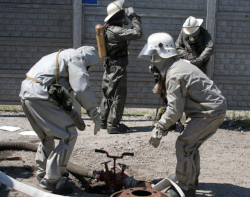Head Protection
Safety helmet (hard hat): This is a hard plastic or rubber helmet and protects the top and side of the head from blows.
Helmets must meet OSHA 1910.135 requirements.
- Helmet liner: Insulates against cold and does not protect against chemical splashes.
- Hood: Commonly worn with a helmet and protects against chemical splashes, particulates, and rain.
- Protective hair covering: Protects against chemical contamination of hair and prevents the entanglement of hair in machinery or equipment. These also prevent hair from interfering with vision and with the functioning of respiratory protective devices. These are important for workers with long hair.
- Suspensions: Provides a gap between the head gear and head, which helps absorb shock and redirect impact force away from the head and spine.
ANSI Hard Hat Types
- Type 1 Hard Hats: Type I hard hats are designed specifically to provide protection from falling objects.
- Type 2 Hard Hats: Type II hard hats provide protection from falling objects, but they also offer protection from lateral impact.
ANSI Classes of Hard Hats
- Class G (General Hard Hats): Class G hard hats are general use hard hats and are the most commonly found hard hats available. They are primarily used to protect against impact and provide electrical protection up to 2200 volts.
- Class E (Electrical Hard Hats): Class E hard hats are approved for use in areas where exposure to electrical hazards is a possibility. They provide the wearer with dielectric protection of as much as 20,000 volts.
- Class C (Conductive Hard Hats): Class C hard hats are not intended to provide any protection against electrical hazards. They only protect against impact.
Knowledge Check Choose the best answer for the question.
2-6. What class of hard hat protects against exposure to up to 20,000 volts?
You forgot to answer the question!

